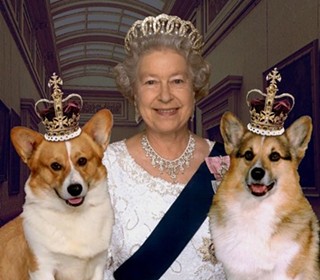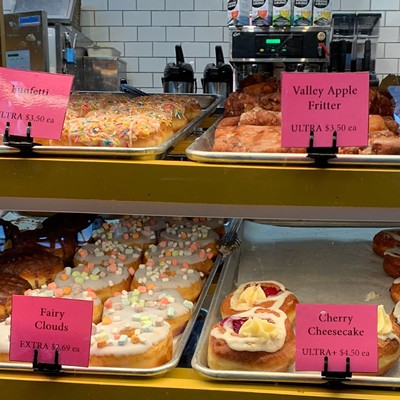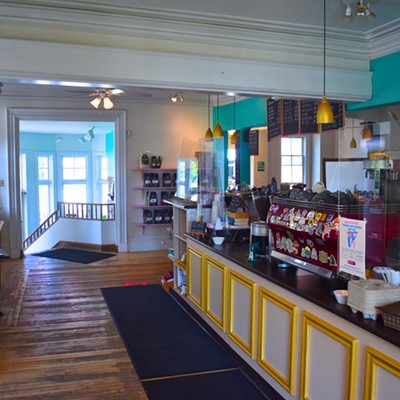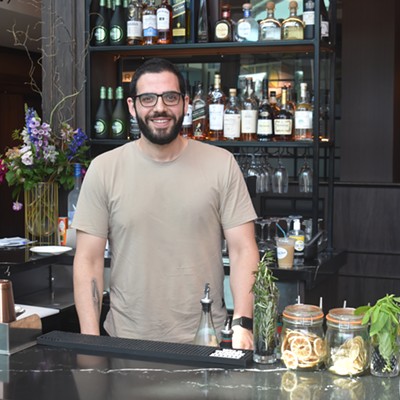Orphanage Clothing is Kim Munson’s line of repurposed and redesigned clothing. A mix of classic t-shirts married with vintage button-downs, dresses cut from trenchcoats and other surprises, Munson, a fashion school and SMU grad, has been selling out of Halifax for five years, and Orphanage is now available across Canada. Anne Pickard, AKA Handy Girl, is in her seventh year in the NSCAD fashion department as a technician and teacher. With a background in fine art, fashion and textiles, Pickard worked for 20 years in film and television costume design, as well as doing custom work, alterations and redesign. Self-taught designer Sherry Lynn Jollymore is a NSCAD grad who ran Junk and Foibles for several years before starting Lost & Found on Agricola with partner Jay Melanson. No longer with the store, her fashion line Fancy-Pants Design, is on hiatus while she works as a seamstress at lululemon and teaches wearable art at AGNS.
Anne Picard: If you want to find out what’s happening in fashion, look at the 14-year-olds. Or even better, look at the 11 year olds. 14 year olds are looking to the 11 year olds these days.
Sherry Jollymore: I like that when you see them, you can see the things they pulled from other things. ‘Oh, is it time for that?’ Have you noticed the World Famous bags, they were canvas? I had one and it was quite a big deal. They were in this natural colour or in a funky blue. Except now they’ve extended the straps, so the strap is quite long. But they were popular when I was 15.
Picard: I think we’re in the age of the individual. While the ’90s were the translucent decade, this is the decade of the individual and you take that and couple it with the green movement and the environmental movement that’s happening right now, and mix them up in a martini shaker, what are you going to get, but redesigned fashion. That is definitely the direction fashion is going on.
I think that the biggest thing we need to think about in terms of taking clothes and redesigning them---we have enough clothes on the earth we never have to make any more---however, there’s a lot of misinformation out there, for example, people thinking it’s better to use cotton than polyester when if the cotton’s not organic, you’re actually doing more harm. Cotton manufacturing takes 50 percent of the pesticides in the world for all industries combined. It’s really, really destructive to the environment.
Jollymore: I like that it seems like anything goes. I’m loving it. I love it. People can wear just about anything, any shoe height, any kind of heel.
Picard: Inspiration comes from many different decades in history as well. There’s not a lot of innovation. There are only so many ways to make a frock, let’s face it. The innovation that’s happening now is that the top you have on (pointing to Munson), no one else in the world will have that because you’ve added this to it or you have taken something that already exists and transformed it.
Kim Munson: It’s one garment, one time, forever. It’s only going to be that one garment, ever, and that’s a huge selling point for my pieces. Even if the styles are the same---no two pieces are the same because they’re cut from different denim or different colours.
So where do you get your stuff from?
Munson: Frenchy’s is my mainstay. Value Village is good, Salvation Army is good too. I get a lot of donations, which is also awesome. But I like to do Frenchy’s, that’s why I love to live in the Maritimes.
Picard: And you go out of Halifax, and they get even better.
Munson: Oh sure, you find the cheesiest stuff.
Picard: There are ingredients to making clothes everywhere. You can turn a backpack into a pair of shorts.
Describe Halifax’s fashion style.
Picard: I’m from Newfoundland, and lived for 10 years in Vancouver, and I’ve been here for eight years now and the thing I’ve noticed the most, out of any other place in Canada, is that people really will wear whatever they want. You don’t see a bias-cut, A-line dress on a plus-sized person walking down the streets of Vancouver, you only see it on tall, skinny, runway model types. Here I think anything goes, that’s what I noticed immediately. Now I notice the individualism. You don’t want the same shirt as everyone else. And the green---eco-chic.
Munson: I think that fashion traditionally has always been a metropolitan endeavor and I find that in Halifax there’s a lot more of the rural connected in there, so you get the airport meets the farm meets metalhead. It’s this whole smattering of goodness.
Jollymore: I do find that people are more arty in the way they dress, and I guess what I mean by that is rubber boots are cool. And in some other places it’s not, you can’t go out with rubber boots on. But here, that completely flies. Like legwarmers, stuff like that. I moved to California a few years ago and living there, they were just dumbfounded by my style---they liked it---but they were like, ‘You’re not from the west coast.’
At the same time I don’t feel like I can be super adventurous here because, and it’s sort of in a flattering way, people want to comment on it too much. Even something like wearing a hat, by the time you’ve made it through the day wearing that hat, you’ve had 15, 20 conversations about your hat. And it’s very well intended, everyone is trying to be quite nice but it gets on my nerves after awhile. So I think it could be a little edgier. I don’t know if anyone else feels that way, but I know there’s more I could be doing, but I don’t because I have to get the bus and I have to walk a certain place.
Picard: I wore a bright red coat one day.
Jollymore: I know! I wore a green one and I got so many compliments. And so many others, ‘What are you doing?’
Has that changed over the last 15 years? Can you do more that you could before?
Jollymore: I feel like it has changed---it’s more diverse too. Even because there are a lot more people, and a more people with a bit more money. Luxury brands have really shot up too, and that was not here.
Munson: I think that fashion has also been a musical movement here too. Fifteen years ago there was the grunge thing when Sloan got big. Now there’s a bit more hip-hop. Music really affects the fashion in Halifax.
What about NSCAD?
Jollimore: Skirts over pants!
What about American Apparel, Lululemon and other brands with really distinctive looks?
Picard: Every city is going to have its Lululemon niche, it’s going to have its American Apparel.
Munson: I think that the more shoppers we can get shopping downtown the better, it doesn’t matter what the store is, as long it’s a fair company. But the more people we can get away from big box retail on the outside and back to the core, the better.
If you could get rid of one thing you see on the streets, what would it be?
Pickard, Munson, Jollymore: CROCS!
What about dudes?
Picard: Dudes are on the way up. A dude will buy face cream now.
Munson: I find that my men’s line goes first. I sell tons of men’s gear and my stores ask me for it because guys have a hard time finding cool stuff.
Jollymore: Good pants.
Munson: Good pants, tops they like. I’ll mix a t-shirt with a button-down; like you get an old Ramones tee and pair it with a pearl-snap vintage button-down. Because there’s only one of those ever made, as long as the fit’s good.
Jollymore: I’ve found guys always wanted it, but it just wasn’t here. Even back in the day, that was 12 years ago or more, when I worked at Junk. They were always looking, and I was like, ‘Sorry guys, we just don’t have it.’
Munson: The funny thing is that when I Googled ‘Halifax style’ to see what would come up, the first thing that did was a recipe for donairs.
Jollymore: I love it! Look, it’s my donair-inspired dress. It’s a wrap!
---Sue Carter Flinn












